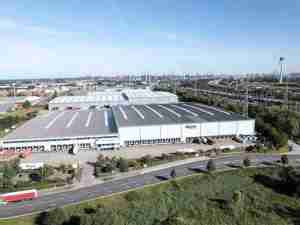Expressed in TEU (20-foot container units), throughput was 8.2 million units, an increase of 2%. The difference between units and weight is a consequence of the regulation of empty containers by the big terminals.
LADEN/EMPTY
Throughput from January to the end of September, in thousands of TEUs:
2007 |
2008 |
Difference |
|
| Laden | 6,257 |
6,563 |
+5% |
| Empty | 1,768 |
1,662 |
-6% |
| Total | 8,025 |
8,225 |
+2% |
TRADES
Of the main trades, North America performed best in the first three quarters (+12%), followed by South America (+5%), Asia (+2% to 3.9 million TEU) and Europe (+1% to 2.7 million TEU). Together, the Americas accounted for 1.4 million TEU (+9%).
Within Europe, there was evidence of shrinkage on the ‘short sea’ routes. The main countries involved here are the UK and Ireland, where the economic decline already started early this year. In 2007, the two countries still accounted for around 2 million TEU. This was 52% of Rotterdam’s ‘European’ container throughput and almost 20% of its total container throughput.
In scale, they are followed by the Iberian Peninsula, where Spain – accounting for 280,000 TEU in 2007 – was hit in the course of the year. In the north, Sweden, Norway and Iceland bore up relatively well until September.
The ‘feeder market’ grew by close on five percent until the end of this month. This market again covers the UK, but mainly the Baltic area and more specifically Russia, with around 500,000 TEU in 2007. Theoretically, the growth of the Russian market should remain intact the best/longest.
European traffic actually declined more strongly towards the end of the quarter. Traffic with Asia, on the other hand, improved slightly. This is related to the traditional level of imports prior to the festive season and the build-up of volume by the CKYH alliance for the Euromax terminal.
FEFC, OTHER PORTS
Just before it was folded up, the Far Eastern Freight Conference (FEFC) announced that the members (accounting for three quarters of the total Far East-Europe volume) achieved 1.9% growth in the first nine months. Although this refers to the westbound traffic and there are differences between Rotterdam’s “Asia” and the area the FEFC used to cover, the Rotterdam picture coincides well with the general one. Hamburg, also with a lot of Asia cargo, is expected to come close to this. Antwerp and Bremerhaven, both strong on the North America trade, could/should be able to record higher growth figures.
COMPARISON WITH 2007
In comparison with the situation/development in 2007 (total throughput 10.8 million TEU) in Rotterdam:
TEUx1000 |
+/- 2006 |
Share of Total |
|
| Asia | 4,855 |
17% |
More Ports & Terminals
CBP officers continue recovering stolen vehicles at Charleston and Savannah seaportsView ArticleAmerica’s ports will reduce air pollution with $150 million in FHWA grantsToday, the American Association of Port Authorities (AAPA), joined by several port leaders at a White House event, celebrated almost $150 million in grants from the Federal Highway Administration's (FHWA)… View ArticleGreat Lakes announces new $150,000,000 second-lien financing agreementGreat Lakes Dredge & Dock Corporation ("Great Lakes" or the “Company”), the largest provider of dredging services in the United States, announced that it has entered into a $150,000,000 5-year,… View Article
GREIWING places megacenter for spices and herbs in operationView Article
Port of Oakland March container volume growsView Article
Georgia Ports CEO: We are preparing for growthView Article© Copyright 1999–2024 American Journal of Transportation. All Rights Reserved |





